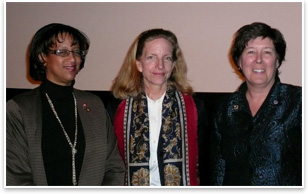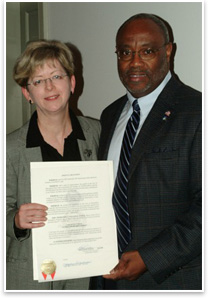
| AIA Northern Virginia Celebrates AIA150
How do you . . . make the AIA150 relevant to community? Summary: The Blueprint for America is the cornerstone of the AIA’s 150th anniversary celebration. Comprising 156 community service projects funded by the AIA, Blueprint for America brings architects and the public together to address community needs related to design and livability. Two of those projects are taking place in the Washington, D.C., suburbs, where AIA Northern Virginia hosted a series of special events and exhibitions, two of which are official AIA150 Blueprint projects: Women Creating Community and the Architecture School Charrette.
For AIA Northern Virginia, the added projects were a natural outgrowth of their annual Architecture Week, which is traditionally programmed for mid-April, says AIA Executive Director Debbie Burns. For example, Burns explains, the annual Canstruction® Competition, featuring teams of architects building structures entirely of canned food, was already on the calendar and, in fact, a highly anticipated event at the local food bank, where the chapter has become the second largest donor of canned goods. (The Boy Scouts take first place.)
Although the event organizers originally envisioned a film documentary, finances dictated that the program would be anchored with a slide show that asked designers for their meaning of community. The slide show will eventually be posted on the chapter Web site, Burns says. The second event, slated for September, is a day-long charrette, guided by a jury of leading architects, to facilitate a dialogue about the importance of design in the creation of livable communities. Architecture students from Virginia Tech, Catholic University, Howard University, and the University of Maryland will participate and be interspersed in cross-collegiate teams, Burns explains. The event will take place at the National Building Museum. Many events (During Brown's tenure, the chapter notes, the Institute was instrumental in developing the Senate Park Commission Plan, which reasserted the open spaces of the 18th-cemtury L’Enfant Plan. As a former assistant of Henry Hobson Richardson, he designed many local buildings and bridges in the Richardsonian Romanesque style. Interested in historic structures, he was involved with documenting and restoring many local structures and authored the first comprehensive history of the U.S. Capitol.) Although not official “Blueprint” activities, the chapter celebrated Architecture Week with a variety of programs, including:
|
||
Copyright 2007 The American Institute of Architects. All rights reserved. Home Page |
||
home
news headlines
practice
business
design
recent related
› AIA Launches “Blueprint for America”
› Minnesotans Kick Off Livable Communities Celebration
› Nevada’s AIA150 Blueprint for Livability
Visit the AIA Northern Virginia Web site.
Perhaps one of the more lighthearted aspects of AIA Northern Virginia’s AIA150 celebration, AIA Northern Virginia Executive Director Debbie Burns says, is that a local radio station featured National Architecture Week on its lunch radio program. The DJ took calls from listeners (mostly from the AIA champions) for “songs, artists, and albums having to do with communities, design, building, and, in some cases, demolition.”
Here’s a list of the songs that were played during the two-hour program.
1. Cities in Dust—Siouxsie & the Banshees
2. Our House—Crosby, Stills, Nash, & Young
3. Our House—Madness
4. City of Blinding Lights—U2
5. Breakdown—Tom Petty
6. My City Was Gone—The Pretenders
7. Another Brick in the Wall—Pink Floyd
8. House of the Rising Sun—The Animals (Tracy Chapman cover)
9. Subdivisions—Rush
10. Happy Hour—Housemartins
11. Brick House—Commodores
These are other suggestions that didn’t make it on the show:
12. Digging in the Dirt—Peter Gabriel
13. Burning Down the House—Talking Heads
14. Bleacker Street—Simon & Garfunkel
15. Building a Mystery—Sarah McLachlan
16. We Built This City—Jefferson Starship
17. Stairway to Heaven—Led Zepplin
18. Window in the Skies—U2
19. Thick as a Brick—Jethro Tull
20. This Must Be the Place (Native Melody)—Talking Heads
21. Anything off of Glass Houses by Billy Joel
22. Anything by the Doors
Images:
Left to right, Kathryn Prigmore, FAIA; Elizabeth Plater-Zyberk, FAIA; and Kate Schwennsen, FAIA, panelists at the Women Creating Community Symposium on April 10.
Photo © Deborah S. Burns.
AIA Northern Virginia Chapter President Marlene Walli Shade, AIA, accepts the AIA150 / Architecture Week Proclamation from Alexandria Mayor William D. Euille at the opening of the Glenn Brown Exhibit on April 12.
Photo © Kathryn Brown

 The first, Women Creating Community, brought together renowned women architects, local architects and designers, and interested community members to discuss visions for beautiful, safe, and livable communities. The chapter’s second Blueprint project, the Architecture School Charrette, which will take place at the end of September, features local architecture students working collaboratively with each other and experienced architects to develop design projects that are responsive to the principles of livable communities.
The first, Women Creating Community, brought together renowned women architects, local architects and designers, and interested community members to discuss visions for beautiful, safe, and livable communities. The chapter’s second Blueprint project, the Architecture School Charrette, which will take place at the end of September, features local architecture students working collaboratively with each other and experienced architects to develop design projects that are responsive to the principles of livable communities. “Blueprinting” events
“Blueprinting” events